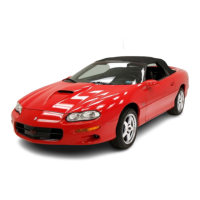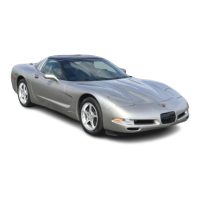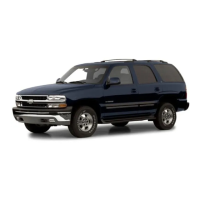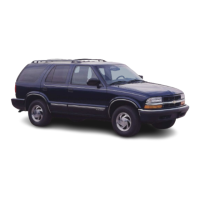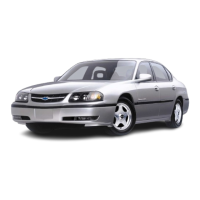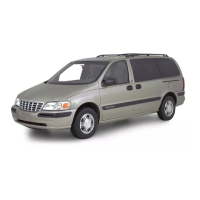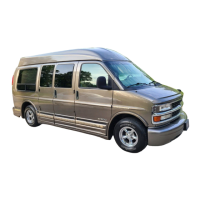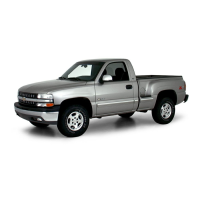Do you have a question about the Chevrolet 2000 Cavalier and is the answer not in the manual?
Explains safety cautions and symbols used in the manual, including "CAUTION" boxes and prohibition symbols.
Details how to adjust front seats, including manual adjustments and lumbar support.
Explains proper safety belt usage and the Supplemental Restraint System (SRS).
Provides step-by-step instructions for adult occupants on wearing lap-shoulder belts correctly.
Explains the proper adjustment of head restraints to reduce neck injury risk in a crash.
Explains the function and operation of the vehicle's air bag system as a supplement to safety belts.
Emphasizes the importance of rear seat passengers buckling up and provides instructions for lap-shoulder belts.
Stresses the need for appropriate child restraints and discusses different types available for infants and children.
Describes the function of the single key for ignition and locks, and the importance of the key tag.
Covers manual and power door locking systems, rear door security locks, and lockout prevention.
Explains how to use the remote transmitter for locking, unlocking, and trunk release.
Explains the different positions of the ignition switch (ACCESSORY, LOCK, OFF, RUN, START).
Provides instructions for starting the engine with automatic and manual transaxles.
Covers the operation of automatic transaxles, including shift lever positions and parking brake engagement.
Provides instructions for operating a 5-speed manual transaxle, including shift patterns and procedures.
Details how to set and release the parking brake and related warnings.
Covers manual and power window operation, including auto-down and lockout features.
Explains the operation of the turn signal, lane change indicator, and headlamp controls.
Covers the operation of cruise control, its limitations, and when not to use it.
Explains the operation of parking lamps and headlamps using the turn signal/multifunction lever.
Introduces the instrument panel and its main components.
Introduces warning lights and gauges that signal vehicle problems and the importance of paying attention to them.
Introduces the climate control system, covering fan, temperature, and mode knobs for ventilation and heating.
Introduces the audio system, its ease of use, and the Retained Accessory Power (RAP) feature.
Covers playing the radio, using volume controls, recalling stations, and finding stations.
Provides instructions for playing cassette tapes, including handling, insertion, and playback controls.
Guides on inserting and playing compact discs, and troubleshooting common playback errors.
Explains the Radio Data System (RDS) features like station seeking and displaying traffic announcements.
Emphasizes the importance of being prepared for unexpected situations and maintaining safe following distances.
Highlights the dangers of drinking and driving, its effects on skills, and legal limits.
Details braking action, perception time, reaction time, and the importance of maintaining following distance.
Explains the function of the anti-lock braking system and its normal self-check procedure.
Explains the Enhanced Traction System (ETS) and its role in limiting wheel spin in slippery conditions.
Details types of skids (braking, steering, acceleration) and how to handle them, including the role of the Enhanced Traction System.
Provides tips for safer night driving, including defensive driving and adjusting to reduced visibility.
Offers advice for driving in wet conditions, emphasizing reduced traction and visibility, and proper wiper maintenance.
Explains the phenomenon of hydroplaning, its causes, and how to avoid it by slowing down.
Warns about the dangers of driving through flowing water, which can carry vehicles away.
Offers advice on safe freeway driving, including merging, speed, lane usage, and exiting.
Lists essential checks before a long trip, including vehicle readiness, personal preparation, and weather/map checks.
Offers tips for winter driving and suggests keeping emergency supplies in the trunk.
Covers towing a vehicle behind another, including recreational towing and using a dolly or flat towing.
Explains how to properly load a vehicle, including weight limits and distribution for safety.
Lists important points for trailer towing, including laws, sway controls, and break-in periods.
Discusses considerations for trailer weight, tongue weight, and total vehicle weight for safe towing.
Covers the experience of towing, including handling, braking, and pre-trip checks.
Advises making wider turns when trailering to avoid contact with the vehicle or surroundings.
Offers advice for driving on steep grades, including engine braking and temperature monitoring.
Provides instructions and safety precautions for parking a vehicle with a trailer on a hill.
Explains how to use hazard warning flashers to alert other drivers or signal a problem.
Provides detailed, step-by-step instructions for safely jump-starting a vehicle's dead battery.
Covers safe towing practices, necessary equipment, and when to consult a professional service.
Addresses engine overheating, identifying causes, and actions to take, including safety warnings about steam.
Identifies components of the cooling system under the hood and warns about electric cooling fans.
Explains what to do if a tire blows out or leaks air, including control techniques and the next steps for changing a tire.
Provides step-by-step instructions for safely changing a flat tire using the jack and tools.
Details the usage, limitations, and maintenance of the compact spare tire.
Offers methods for freeing a stuck vehicle, including the "rocking" technique and cautions against wheelspin.
Recommends dealer service and highlights genuine GM parts, also covers doing own service work.
Advises on using the correct unleaded gasoline octane rating and avoiding fuels with methanol.
Details the procedure for refueling the vehicle and includes safety precautions regarding gasoline vapor.
Explains how to open the hood and identifies key components under the hood for inspection.
Explains the importance of checking engine oil level and how to do it for different engine types.
Guides on selecting the correct engine oil based on API certification and viscosity grades.
Locates the air cleaner and explains how to check or replace the filter.
Explains when to check and change automatic transaxle fluid for three-speed models.
Explains the cooling system, coolant type (DEX-COOL), and its benefits like freezing and boiling protection.
Explains how to check coolant level and identifies the surge tank location, warning about hot systems.
Explains when to check power steering fluid and how to check and add it if necessary.
Advises on using the correct washer fluid and precautions for adding it, especially in cold weather.
Discusses brake fluid level, reasons for it going down, and warnings about adding fluid.
Explains how to identify worn brake pads via a warning sound and discusses brake squeal.
Recommends ACDelco batteries and provides advice on vehicle storage and battery care.
Introduces bulb replacement procedures and refers to the index for specific bulb types.
Provides detailed steps for removing and replacing headlamp assemblies and bulbs.
Discusses tire maintenance, safety, and the dangers of improper tire usage like overloading or under/over-inflation.
Explains how to check tire pressure and the importance of correct inflation for tire wear and safety.
Details tire inspection for wear and damage, and the procedure for tire rotation for uniform wear.
Discusses the importance of proper wheel alignment and balance for tire life and vehicle handling.
Introduces appearance care and lists cleaning products to avoid due to potential damage.
Provides tips for cleaning interior surfaces like vinyl, leather, and plastic with a damp cloth.
Instructs on keeping safety belts clean and dry, and warns against bleaching or dyeing them.
Covers washing the vehicle to preserve paint finish, recommending specific soaps and drying methods.
Explains the VIN's purpose as a legal identifier and its locations on the vehicle.
Covers add-on electrical equipment, air bag system interactions, and potential vehicle damage.
Explains how fuses and circuit breakers protect vehicle wiring and how to replace them.
Explains the importance of proper maintenance for vehicle condition and environmental protection.
Details services to be performed and their frequency, emphasizing dealer service for complex tasks.
Lists maintenance services required for vehicles used primarily for short trips or city driving.
Lists maintenance services for vehicles used for long distances or in severe conditions.
Details checks and services owners can perform themselves at specified intervals.
Lists underhood checks recommended at each fuel fill, including oil and coolant levels.
Emphasizes checking tire pressure regularly, including the compact spare tire.
Recommends semi-annual checks for restraint systems, wiper blades, and weatherstrip lubrication.
Guides on checking safety belts, buckles, and air bag coverings for proper function and damage.
Lists periodic inspections for steering, suspension, drive axle, exhaust, cooling, and throttle systems.
Covers inspection of brake lines, pads, drums, calipers, and parking brake, recommending frequent checks based on driving.
Lists recommended fluids and lubricants by name, part number, or specification for vehicle maintenance.
Provides a log for recording maintenance dates, odometer readings, and services performed for warranty and tracking.
Outlines a three-step procedure for resolving customer concerns with dealers and Chevrolet.
Lists contact addresses and phone numbers for Chevrolet Customer Assistance Centers in the US and Canada.
Describes the GM Mobility Program, including reimbursement for adaptive equipment and resource information.
Explains the free Roadside Assistance program, its services, and contact numbers.
Details the Courtesy Transportation program for customers needing service, including shuttle and reimbursement options.
Instructs on reporting vehicle safety defects to NHTSA and provides contact information.
Encourages owners to report safety defects directly to General Motors via phone or mail.
Details how to order service manuals, unit repair manuals, and other service publications.
Explains safety cautions and symbols used in the manual, including "CAUTION" boxes and prohibition symbols.
Details how to adjust front seats, including manual adjustments and lumbar support.
Explains proper safety belt usage and the Supplemental Restraint System (SRS).
Provides step-by-step instructions for adult occupants on wearing lap-shoulder belts correctly.
Explains the proper adjustment of head restraints to reduce neck injury risk in a crash.
Explains the function and operation of the vehicle's air bag system as a supplement to safety belts.
Emphasizes the importance of rear seat passengers buckling up and provides instructions for lap-shoulder belts.
Stresses the need for appropriate child restraints and discusses different types available for infants and children.
Describes the function of the single key for ignition and locks, and the importance of the key tag.
Covers manual and power door locking systems, rear door security locks, and lockout prevention.
Explains how to use the remote transmitter for locking, unlocking, and trunk release.
Explains the different positions of the ignition switch (ACCESSORY, LOCK, OFF, RUN, START).
Provides instructions for starting the engine with automatic and manual transaxles.
Covers the operation of automatic transaxles, including shift lever positions and parking brake engagement.
Provides instructions for operating a 5-speed manual transaxle, including shift patterns and procedures.
Details how to set and release the parking brake and related warnings.
Covers manual and power window operation, including auto-down and lockout features.
Explains the operation of the turn signal, lane change indicator, and headlamp controls.
Covers the operation of cruise control, its limitations, and when not to use it.
Explains the operation of parking lamps and headlamps using the turn signal/multifunction lever.
Introduces the instrument panel and its main components.
Introduces warning lights and gauges that signal vehicle problems and the importance of paying attention to them.
Introduces the climate control system, covering fan, temperature, and mode knobs for ventilation and heating.
Introduces the audio system, its ease of use, and the Retained Accessory Power (RAP) feature.
Covers playing the radio, using volume controls, recalling stations, and finding stations.
Provides instructions for playing cassette tapes, including handling, insertion, and playback controls.
Guides on inserting and playing compact discs, and troubleshooting common playback errors.
Explains the Radio Data System (RDS) features like station seeking and displaying traffic announcements.
Emphasizes the importance of being prepared for unexpected situations and maintaining safe following distances.
Highlights the dangers of drinking and driving, its effects on skills, and legal limits.
Details braking action, perception time, reaction time, and the importance of maintaining following distance.
Explains the function of the anti-lock braking system and its normal self-check procedure.
Explains the Enhanced Traction System (ETS) and its role in limiting wheel spin in slippery conditions.
Details types of skids (braking, steering, acceleration) and how to handle them, including the role of the Enhanced Traction System.
Provides tips for safer night driving, including defensive driving and adjusting to reduced visibility.
Offers advice for driving in wet conditions, emphasizing reduced traction and visibility, and proper wiper maintenance.
Explains the phenomenon of hydroplaning, its causes, and how to avoid it by slowing down.
Warns about the dangers of driving through flowing water, which can carry vehicles away.
Offers advice on safe freeway driving, including merging, speed, lane usage, and exiting.
Lists essential checks before a long trip, including vehicle readiness, personal preparation, and weather/map checks.
Offers tips for winter driving and suggests keeping emergency supplies in the trunk.
Covers towing a vehicle behind another, including recreational towing and using a dolly or flat towing.
Explains how to properly load a vehicle, including weight limits and distribution for safety.
Lists important points for trailer towing, including laws, sway controls, and break-in periods.
Discusses considerations for trailer weight, tongue weight, and total vehicle weight for safe towing.
Covers the experience of towing, including handling, braking, and pre-trip checks.
Advises making wider turns when trailering to avoid contact with the vehicle or surroundings.
Offers advice for driving on steep grades, including engine braking and temperature monitoring.
Provides instructions and safety precautions for parking a vehicle with a trailer on a hill.
Explains how to use hazard warning flashers to alert other drivers or signal a problem.
Provides detailed, step-by-step instructions for safely jump-starting a vehicle's dead battery.
Covers safe towing practices, necessary equipment, and when to consult a professional service.
Addresses engine overheating, identifying causes, and actions to take, including safety warnings about steam.
Identifies components of the cooling system under the hood and warns about electric cooling fans.
Explains what to do if a tire blows out or leaks air, including control techniques and the next steps for changing a tire.
Provides step-by-step instructions for safely changing a flat tire using the jack and tools.
Details the usage, limitations, and maintenance of the compact spare tire.
Offers methods for freeing a stuck vehicle, including the "rocking" technique and cautions against wheelspin.
Recommends dealer service and highlights genuine GM parts, also covers doing own service work.
Advises on using the correct unleaded gasoline octane rating and avoiding fuels with methanol.
Details the procedure for refueling the vehicle and includes safety precautions regarding gasoline vapor.
Explains how to open the hood and identifies key components under the hood for inspection.
Explains the importance of checking engine oil level and how to do it for different engine types.
Guides on selecting the correct engine oil based on API certification and viscosity grades.
Locates the air cleaner and explains how to check or replace the filter.
Explains when to check and change automatic transaxle fluid for three-speed models.
Explains the cooling system, coolant type (DEX-COOL), and its benefits like freezing and boiling protection.
Explains how to check coolant level and identifies the surge tank location, warning about hot systems.
Explains when to check power steering fluid and how to check and add it if necessary.
Advises on using the correct washer fluid and precautions for adding it, especially in cold weather.
Discusses brake fluid level, reasons for it going down, and warnings about adding fluid.
Explains how to identify worn brake pads via a warning sound and discusses brake squeal.
Recommends ACDelco batteries and provides advice on vehicle storage and battery care.
Introduces bulb replacement procedures and refers to the index for specific bulb types.
Provides detailed steps for removing and replacing headlamp assemblies and bulbs.
Discusses tire maintenance, safety, and the dangers of improper tire usage like overloading or under/over-inflation.
Explains how to check tire pressure and the importance of correct inflation for tire wear and safety.
Details tire inspection for wear and damage, and the procedure for tire rotation for uniform wear.
Discusses the importance of proper wheel alignment and balance for tire life and vehicle handling.
Introduces appearance care and lists cleaning products to avoid due to potential damage.
Provides tips for cleaning interior surfaces like vinyl, leather, and plastic with a damp cloth.
Instructs on keeping safety belts clean and dry, and warns against bleaching or dyeing them.
Covers washing the vehicle to preserve paint finish, recommending specific soaps and drying methods.
Explains the VIN's purpose as a legal identifier and its locations on the vehicle.
Covers add-on electrical equipment, air bag system interactions, and potential vehicle damage.
Explains how fuses and circuit breakers protect vehicle wiring and how to replace them.
Explains the importance of proper maintenance for vehicle condition and environmental protection.
Details services to be performed and their frequency, emphasizing dealer service for complex tasks.
Lists maintenance services required for vehicles used primarily for short trips or city driving.
Lists maintenance services for vehicles used for long distances or in severe conditions.
Details checks and services owners can perform themselves at specified intervals.
Lists underhood checks recommended at each fuel fill, including oil and coolant levels.
Emphasizes checking tire pressure regularly, including the compact spare tire.
Recommends semi-annual checks for restraint systems, wiper blades, and weatherstrip lubrication.
Guides on checking safety belts, buckles, and air bag coverings for proper function and damage.
Lists periodic inspections for steering, suspension, drive axle, exhaust, cooling, and throttle systems.
Covers inspection of brake lines, pads, drums, calipers, and parking brake, recommending frequent checks based on driving.
Lists recommended fluids and lubricants by name, part number, or specification for vehicle maintenance.
Provides a log for recording maintenance dates, odometer readings, and services performed for warranty and tracking.
Outlines a three-step procedure for resolving customer concerns with dealers and Chevrolet.
Lists contact addresses and phone numbers for Chevrolet Customer Assistance Centers in the US and Canada.
Describes the GM Mobility Program, including reimbursement for adaptive equipment and resource information.
Explains the free Roadside Assistance program, its services, and contact numbers.
Details the Courtesy Transportation program for customers needing service, including shuttle and reimbursement options.
Instructs on reporting vehicle safety defects to NHTSA and provides contact information.
Encourages owners to report safety defects directly to General Motors via phone or mail.
Details how to order service manuals, unit repair manuals, and other service publications.
| Brand | Chevrolet |
|---|---|
| Model | 2000 Cavalier |
| Category | Automobile |
| Language | English |
